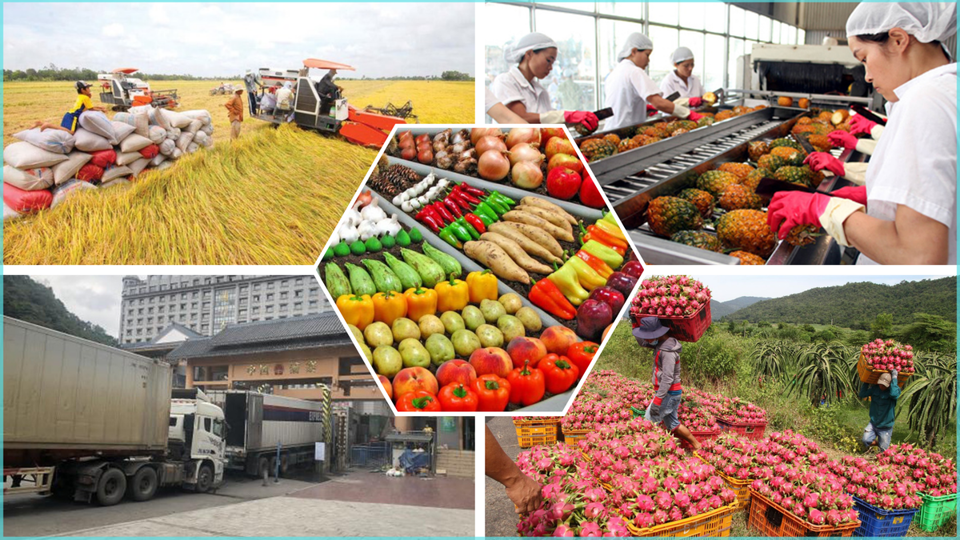Kinhtedothi – China is currently the largest export market for Vietnamese agricultural products. Experts and managers predict that the scale and value of agricultural exports to this country of 1.4 billion people will grow strongly in the coming time thanks to many favorable factors.
No. 1 Export Market
First of all, it is necessary to affirm that one of the important priorities in economic, trade and investment cooperation between Vietnam and China is that both sides continue to strive to maintain a stable, balanced and sustainable development trend; actively promote and promptly complete procedures to bring more Vietnamese products with strengths to export to China, especially agricultural and aquatic products.
In recent times, China has always been identified as a large and important export market for agricultural, forestry and aquatic products of Vietnam. According to information from the Ministry of Agriculture and Rural Development, in the first 9 months of 2024, the export turnover of agricultural, forestry and aquatic products to China reached 9.26 billion USD, of which the export turnover of vegetables and fruits reached 3.4 billion USD, an increase of 36% over the same period in 2023. With this result, China continues to be the largest export market for Vietnamese vegetables and fruits in the past 9 months.
To date, Vietnam has officially exported 14 agricultural products to the Chinese market: durian, bird’s nest, sweet potato, dragon fruit, longan, rambutan, mango, jackfruit, watermelon, banana, black jelly, mangosteen, lychee and passion fruit. Vietnamese durian, dragon fruit… are very popular with Chinese consumers, the import volume of these products from Vietnam accounts for about 1/5 of the total agricultural product import volume from ASEAN.
Minister of Industry and Trade Nguyen Hong Dien said that recently, the ministry has closely coordinated with the Ministry of Agriculture and Rural Development in negotiating with China to open more export markets for other Vietnamese fruit and vegetable products such as green-skinned grapefruit, fresh coconut, avocado, pineapple, star apple, lemon, melon, etc. In addition, there is a proposal to improve efficiency and regulate the speed of customs clearance of import and export goods at the border gate area between Vietnam and China; especially for seasonal agricultural and aquatic products, as well as quickly and strongly shifting to official export.

With the above efforts, during the visit of General Secretary and President To Lam to China in August 2024, the Ministry of Agriculture and Rural Development and the General Department of Customs of China signed 3 protocols, paving the way for the export of fresh coconut, frozen durian and crocodile to the Chinese market.
The signing of protocols allowing the official export of agricultural products has created momentum for many types of Vietnamese agricultural products in this market. For example, durian: after the Protocol on the official export of durian to China, the export value of durian from Vietnam to this market in the past 2 years has been much larger than the previous years combined. In 2022, durian exports reached 420 million USD, in 2023 they reached 2.3 billion USD, 5 times higher than in 2022 and 10 times higher than in 2021, of which over 90% were exported to China.
However, the results achieved in the past have not been commensurate with the potential, needs and strengths of each side. According to the Director of the Trade Promotion Agency (Ministry of Industry and Trade) Vu Ba Phu, currently, in addition to 14 types of agricultural products exported through official channels, most of the remaining items are exported through border trade channels (informal trade).
Meanwhile, the demand for fruit consumption in the Chinese market is very large and the ability to supply high-quality, specialty fruits of Vietnam is abundant. Along with that is the advantage of bilateral and multilateral trade agreements of which the two countries are members. In addition, Vietnam is also a country with more than 1,450km of border (waterway, road) with China, so logistics costs are low and more competitive than other countries. Therefore, there is still a lot of room for fruit businesses of the two countries to exploit and develop.
Organize production systematically, increase official exports
Although China may sign more Protocols for many Vietnamese agricultural products in the near future, the challenge for domestic enterprises and farmers is to comply with the growing areas, packaging facilities, food safety and hygiene, plant quarantine, and meet all technical barriers. If just one of these standards is not met, the goods will not be cleared through customs, which will be a minus point for Vietnamese agricultural products.
Many experts also commented that only well-organized production can go the long way, not only to China, but to many markets around the world. Therefore, to maintain the reputation and market for Vietnamese agricultural products, the Ministry of Agriculture and Rural Development needs to resolutely direct specialized units in monitoring the codes after growing areas and packaging facility codes to meet the requirements on plant quarantine as well as food safety stipulated in the protocols.
Deputy Minister of Agriculture and Rural Development Phung Duc Tien assessed: agricultural products in general and fruits in particular have great potential in the Chinese market. Notably, many types of fruits such as durian, mango, dragon fruit, lychee, longan, banana… have long been favored by Chinese consumers.
However, to seize the opportunities in the Chinese market, Vietnamese fruits and vegetables need to overcome weaknesses in uneven quality as well as unstable output to meet the needs of large importers and distributors in China. In addition, it is necessary to promote official commercial exports for sustainable development and increased export value.
To develop sustainably in the Chinese market, experts and managers emphasize that Vietnamese enterprises need to focus on quality, unique flavors and food safety.
When Chinese consumers perceive these values, they will become loyal customers, creating a foundation for the long-term development of Vietnamese agricultural products. For example, exporting fruits and vegetables to the Chinese market, with the current growth trend and increasing consumption demand of the Chinese market, it is predicted that Vietnamese fruits and vegetables have the potential to reach the 5 billion USD mark in 2024 and reach the 10 billion USD mark in the future.
Talking about solutions to develop the Chinese market, Deputy Director of the Department of Asia – Africa Market (Ministry of Industry and Trade) To Ngoc Son said that timely information capture and flexible adaptation to changes in the Chinese market are extremely necessary to maintain and develop the export market.
Currently, many Vietnamese agricultural products have basically dominated the Chinese market, the issue that export enterprises need to pay attention to is how to maintain market share as well as increase added value for exported fruits. For agricultural products whose export value to the market is still modest such as mango, longan, etc., it is necessary to focus on market research, brand building and trade promotion to boost export value to this market.
In addition, enterprises need to proactively recruit employees who are fluent in Chinese to be able to transact directly, learn about market information as well as related regulations of the Chinese side to be more proactive in doing business with the market. On the other hand, it is necessary to focus on trade promotion such as proactively participating in specialized fairs on agricultural products in China to promote and introduce products, especially branded agricultural products. Thereby, finding reputable importers to export agricultural products to the Chinese market in a formal and methodical manner.
Source: https://kinhtedothi.vn/xuat-khau-nong-san-sang-trung-quoc-tiep-da-tang-truong-manh.html
